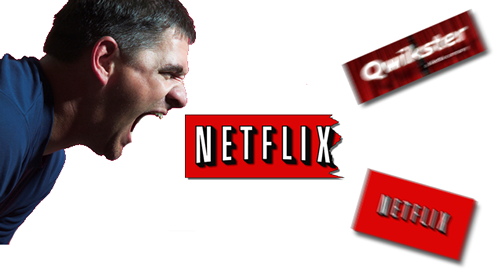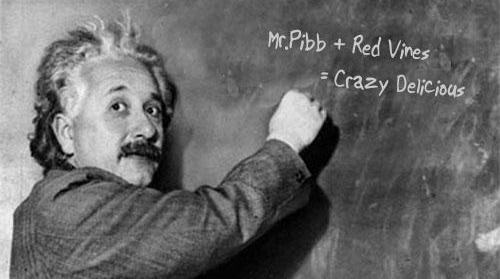Reed Hastings seems like a bright guy. He handily trounced the incumbent DVD rental giants (e.g., Blockbuster, Hollywood Video), and currently has a commanding lead in the movie streaming market. So why on earth is he destroying what he’s built?

What’s happening to Netflix?
Reed Hastings, CEO of Netflix, recently wrote a blog post to customers about some upcoming changes to the Netflix we know today:
It is clear from the feedback over the past two months that many members felt we lacked respect and humility in the way we announced the separation of DVD and streaming, and the price changes. That was certainly not our intent, and I offer my sincere apology.
Translation: “We’re sorry that we did a poor job of telling you bad news, but the bad news was going to happen no matter what.”
Many members love our DVD service, as I do, because nearly every movie ever made is published on DVD, plus lots of TV series. We want to advertise the breadth of our incredible DVD offering so that as many people as possible know it still exists, and it is a great option for those who want the huge and comprehensive selection on DVD.
“We have a crap-ton of content available on DVD.”
DVD by mail may not last forever, but we want it to last as long as possible.
“DVDs by mail is a dying business.”
I also love our streaming service because it is integrated into my TV, and I can watch anytime I want. The benefits of our streaming service are really quite different from the benefits of DVD by mail. We feel we need to focus on rapid improvement as streaming technology and the market evolve, without having to maintain compatibility with our DVD by mail service.
“DVDs are old and busted. Streaming is the new hotness — the new shiny.”
So we realized that streaming and DVD by mail are becoming two quite different businesses, with very different cost structures, different benefits that need to be marketed differently, and we need to let each grow and operate independently.
“Blah, blah, internal corporate structure, blah.”
It’s hard for me to write this after over 10 years of mailing DVDs with pride, but we think it is necessary and best: In a few weeks, we will rename our DVD by mail service to “Qwikster”.
“I’m retarded.”
A negative of the renaming and separation is that the Qwikster.com and Netflix.com websites will not be integrated. So if you subscribe to both services, and if you need to change your credit card or email address, you would need to do it in two places. Similarly, if you rate or review a movie on Qwikster, it doesn’t show up on Netflix, and vice-versa.
“Nevermind that web services and data integration are commonplace across the web in this day and age. Bring back the 90’s!”
The additional streaming content we have coming in the next few months is substantial, and we are always working to improve our service further.
Let’s bookmark this.
The Reaction
The reaction is overwhelmingly negative, from tech industry insiders and non-techies alike.

When I first read Reed’s blog post on Sunday night, there were 245 comments. This morning, there were 11,237 comments. As I write this, there are 21,747 21,872 comments — nearly every single one of them is outraged by what this means for customers.
As usual, Twitter is aflutter with comments.
So Netflix nearly doubles prices, and--by way of apology--makes doing business with them twice as time-consuming and inconvenient? Superb.
— Deanna Raybourn (@deannaraybourn) September 19, 2011
Announcing a new company/brand with an apology is not a great way to instill confidence in your investors. #qwikster #netflix
— Paul Medico (@PaulMedico) September 19, 2011
Netflix: "we heard you don't like paying more for dvd+streaming, so we're also going to make them not work together anymore. You're welcome"
— Ben Zibble (@bzibble) September 19, 2011
Matt Dudley (deleted):
Imagine if @Netflix and Qwikster combined services… unlimited DVD rentals and streaming. Now THAT would be awesome.
And here’s my personal favorite, from Wonderella:
I just got an email from Netflix's CEO telling me to - and I'm paraphrasing - "Please start torrenting".
— Simply Having a Wonderella Christmastime (@wonderella) September 19, 2011
(Bonus: The Oatmeal and The Joy of Tech chime in.)
Personally, I’ve not only been a Netflix customer for a long time (since 2005-ish), but I’ve also been a Netflix fan. I didn’t mind so much when they split up the DVD/streaming accounts and started charging a little more. Netflix + Hulu has completely replaced my cable package.
I suppose my concerns are mostly around the usability of everything. There are lots of third-party services trying to make it easier to watch what you want, regardless of the service. I look up movie/show descriptions on IMDb, movie posters from The Movie DB, stream content from Hulu or Netflix, download content from iTunes, or get a DVD by mail from Netflix (for titles that aren’t available digitally). I would love to see more integration, rather than fragmenting the services even more.
A Fundamental Change in the Product
Joshua Porter of Bokardo.com had this to say:
Netflix is taking a huge risk here. They’re changing the user experience of their web apps to model the new company structure, not a structure that is most friendly to people. This is an extremely common problem in user interface design. Netflix is in serious danger of breaking the user experience they are well-known for.
If you read through even a fraction of comments on the aforementioned Netflix blog post, a very large percentage of users agree with this analysis. Almost everybody has the same concern.

As one commenter complains there will now be two separate movie queues, one on Netflix for DVD and one on Qwikster for streaming. Hastings’ response is dismissive:
We already have two queues. The two “sites” are a click between each other, so we think not that much different than two tabs on one site.
Technically, Hastings is right about there already being two queues. But he’s dead wrong about it being much different. Obviously he’s never watched people use web applications before. Changing websites is not even close to the same thing as changing tabs. When you change websites you go somewhere different, you get a different UI, you’re using a different username, and you probably have to log in. You have a different payment system. Different family members to add. Different recommendations to look at. And that’s just for starters. […]
This is a fundamental change in the product, and Hastings just dismisses the concern with a wave of his hand.
Clearly, the team at Netflix — known for its engineering prowess — has overlooked how its “not that much different” changes will affect the overall customer experience.
Also, people don’t think they’re buying two services right now…they’re simply buying Netflix. As another commenter points out:
You’re continuing to make a classic mistake: thinking you’re something different than what everyone believes you are. You’re not a DVD company and a streaming company: you’re where I go to watch movies. That’s it. The future clearly is streaming, but by separating and charging more for access, you’re wildly less valuable to me. I’ll likely cancel. You haven’t listened to customer feedback. You’re delusional and you’re lost."
Railroad companies failed to understand that they were in the transportation business and were surpassed by the airlines. Newspaper companies failed to understand that they were in the information business and were surpassed by blogs. Record stores failed to understand that they were in the business of selling music and the were surpassed by the Napster Revolution. It’s a classic mistake.
Catalog Size, Deintegration and Price-Hikes — Oh My!
Netflix’ current streaming selection is, at best, abysmal. A couple of months ago, I was getting ready to move and decided to digitize my DVD collection so that I wouldn’t have to drag them along with me. I figured that most of my movies would be available for streaming, so that would save me the time of digitizing the DVDs that I didn’t need to.
As it turned out, I ended up having to digitize the majority of my DVDs because they weren’t available for streaming. I’m still working my way through the stack.

Earlier in the summer, Netflix decided to separate the DVD and streaming plans into separate offerings, with separate pricing for each. Despite Netflix’ best efforts to spin it positively, customers didn’t buy the explanation. Erick Schonfeld of Techcrunch said it best:
Raising prices for those of us who opt for both streaming and DVDs would have been fine if Netflix had a deeper streaming catalog. But the gap is still too big, and the price hike seemed premature. Your customers are extremely loyal. Don’t piss them off.
(Aside: Bill Gurley from Above the Crowd makes a very interesting case for why he believes Netflix was forced to raise their prices. I would likely end up quoting his entire piece here, so I’ll just link to “Understanding Why Netflix Changed Pricing” instead.)
A few months before that, Netflix removed the ability for customers to add movies to their DVD queues from non-computer devices. If you look up a movie on your iPhone, iPad, Android phone, Playstation 3, Xbox 360, Wii or other non-computer device, and it isn’t available for streaming, you need to do the search all over again from your computer before you can add it to your queue.
Now Netflix is looking to make a move that is making customers even angrier: Not only are they separating the DVD and streaming queues into separate websites, but they’re also separating user accounts, credit card updates, ratings, reviews, recommendations, and everything else. Instead of the simplicity of one location for your movies, you now have to deal with two.
Whither Qwikster?
Back to Reed Hastings’ blog post:
Andy Rendich, who has been working on our DVD service for 12 years, and leading it for the last 4 years, will be the CEO of Qwikster. Andy and I made a short welcome video. (You’ll probably say we should avoid going into movie making after watching it.) We will let you know in a few weeks when the Qwikster.com website is up and ready. It is merely a renamed version of the Netflix DVD website, but with the addition of video games. You won’t have to do anything special if you subscribe to our DVD by mail service. […]
Some members will likely feel that we shouldn’t split the businesses, and that we shouldn’t rename our DVD by mail service. […] But going forward, Qwikster will continue to run the best DVD by mail service ever, throughout the United States. Netflix will offer the best streaming service for TV shows and movies, hopefully on a global basis.
Streaming is the future. Everybody knows it. You know it, I know it, Reed Hastings knows it, and Andy Rendich sure as heck knows it. When was the last time you decided to add a movie to your DVD queue if it was already available for streaming? When is streaming ever not your first choice?

Erick Schonfeld of Techcrunch breaks down the numbers:
Still, it’s not enough to offset the drop-off in DVD subscribers. Of the 1 million fewer subscribers Netflix now expects, 800,000 will be from DVD-only subscribers. The remaining 200,000 decline will come from streaming-only subs, with the number who pay for both remaining steady. Out of Netflix’s expected 24 million subscribers this year, 21.8 million will have access to streaming in some form, and only 2.2 million will stick to DVD-only subscriptions.
That doesn’t sound like a very large business. As a matter of fact, that’s a business that’s shrinking. Surely Andy Rendich has seen these numbers, so why would he agree to become the new CEO of a born-to-fail business?
Crazy or Genius?
Looking at this series of events from the outside, I can only see two possible rationales that explain why they’re doing what they’re doing.
- They’re bat-shit crazy.
- They know something that we don’t, which will make all of this headache worth it.
Reed Hastings and Co. have always seemed like a sharp bunch. They started the company with the notion of putting the customer first and over time they have built a successful business around that premise.

Recently, Netflix and Starz decided to end their business relationship, yet Reed Hastings said:
The additional streaming content we have coming in the next few months is substantial, and we are always working to improve our service further.
I can’t help but compare present-day Netflix to Apple in 1985. The Macintosh was clearly the future of computing, but after a solid start, sales were starting to drop off. There weren’t enough applications and the hardware was considered too expensive. The Apple II, on the other hand, was a cash-cow with a large application library at its disposal. Steve Jobs ended up losing his job over the “failure” of the Macintosh. Fast-forward to today: Macs are selling like hotcakes — faster than the entire computer industry — and the Apple line of computers died out 25 years ago.
I think Netflix currently finds itself in a similar position. They know that streaming is the future, if not the now. They are working to grow their streaming content library every day. No, the amount of content comes nowhere near that of their DVDs-by-mail business, but it will.
Qwikster will eventually fade into a footnote in history — and I believe that this has been the plan all along. What better way to sunset the legacy product and grow the new product than to remove the distractions entirely? All of the built-up brand equity is staying with their newer product, streaming video, while the legacy product gets pushed out the back door with a stupid name and a $20-bill pinned to its collar. This isn’t an accident.
I hope that the team at Netflix continues to ride the fine line between crazy and genius for all it’s worth. That said, I can’t help but feel that in their rush to move into the future, they’re bungling the present. Hastings and Rendich need to take a moment to slow down, listen to what customers want (instead of just what they’re asking for), and make this transition from DVDs to streaming as smooth as possible.